Seagate 7200.9 160GB: The Highest Platter Density to Date!
by Purav Sanghani on January 31, 2006 10:29 PM EST- Posted in
- Storage
Real World Tests
Synthetic benchmarks are not always the best gauge in measuring the "real" performance of hardware, which is why we have incorporated a few real world tests in our storage reviews. One of our tests, the file system performance test, measures the drive's ability to handle file zip, unzip, and copy operations. This is a great measure of how one drive compares to another and we have put together a group of tasks that most of us typically use.
File System Tasks Within Drive
Synthetic benchmarks are not always the best gauge in measuring the "real" performance of hardware, which is why we have incorporated a few real world tests in our storage reviews. One of our tests, the file system performance test, measures the drive's ability to handle file zip, unzip, and copy operations. This is a great measure of how one drive compares to another and we have put together a group of tasks that most of us typically use.
File System Tasks Within Drive
- File Zip Test - We take a 300MB file and measure the time that it takes for our test bed to compress it to ZIP format. We then run the test again with 300 1MB files to see how the drive performs when working with multiple files.
- File Unzip Test - Using the same methodology as the File Zip Test, we take a ZIP file of a single 300MB file as well as a ZIP file of 300 1MB files and measure the time that it takes to uncompress each ZIP successfully.
- File Copy Test - We measure how long it takes for the system with our test drive to copy a single 300MB file as well as 300 1MB files.

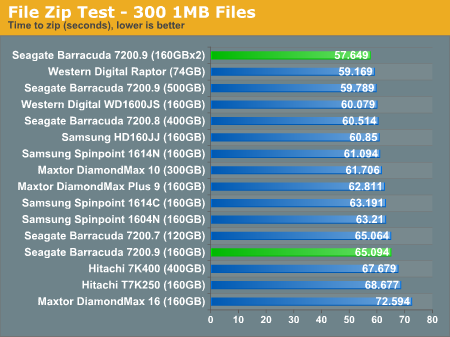
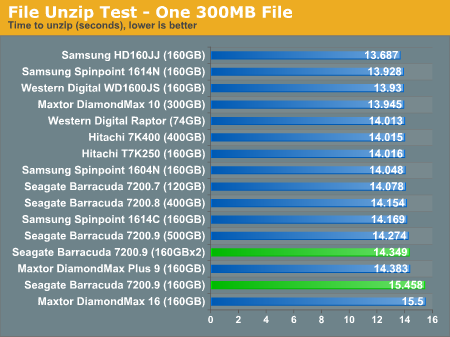
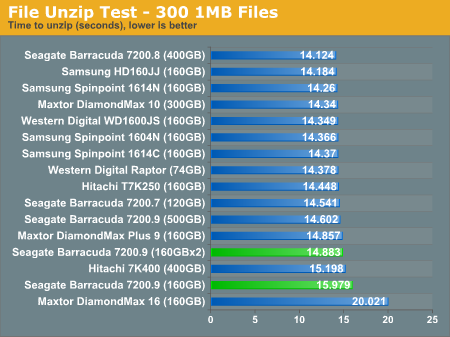
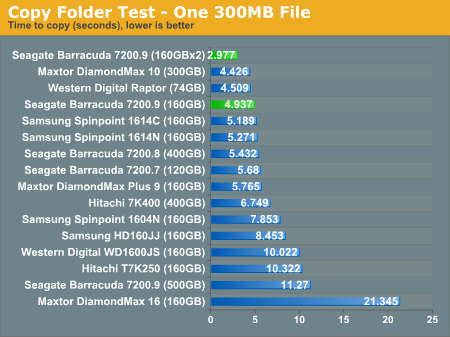
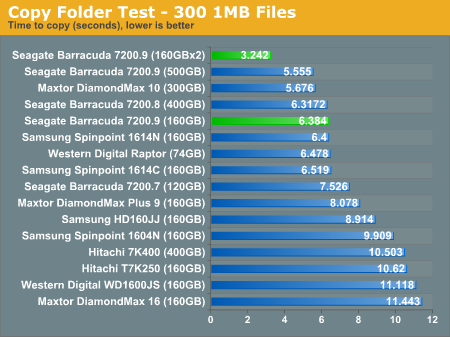










23 Comments
View All Comments
PuravSanghani - Wednesday, February 1, 2006 - link
Hey everyone,The thermal and acoustic results are now in the graphs. We pulled the article last week because of the missing data. Enjoy!
Purav
Mr Perfect - Wednesday, February 1, 2006 - link
Well, the thermals arn't anything special, but the accustics are the quietest ones on the cart. :) Might not be important to some, but it's got me interested.Lord Raiden - Friday, January 27, 2006 - link
Thats what I was exactly thinking. A mistake? Or was it deliberately done?In my humble opinion, Seagate has the most respected drivsin the market for so many years so far. I sense some strange shifting of the mood in some reviewers articles around the world favouring the other companies in the reviews. Like Chip, the most selling, most respected magazine has monthly tables with TOP10 drives and seagate scores 9th out of 10 while his scores in particular cateories are comparative with top three every month... i laugh at that table as it is clear evidence of them being not really fair in judgements...
Anandtech is a respectable site and to believe they wasted a whole page talking about temperature where the drive discussed won't appear at all is simply strange.
:-) Maybe they got confused whether to add temperatures of two drives in RAID or make an average out of them... ;-)
Lord Raiden - Friday, January 27, 2006 - link
Ooops,... like CHip, the most selling, most respected magazine in my country...
ATWindsor - Friday, January 27, 2006 - link
Yeah, that was one of the most interesting things to know, I want to now how warm and noisy it is...Ender17 - Friday, January 27, 2006 - link
"We are itching to see the performance of a RAID-0 array with Raptors!"Didn't Anand already write an article on that back in 2004?
http://www.anandtech.com/storage/showdoc.aspx?i=21...">http://www.anandtech.com/storage/showdoc.aspx?i=21...
Western Digital's Raptors in RAID-0: Are two drives better than one?
Scarceas - Saturday, February 4, 2006 - link
They need to compare a single drive not just to a 2 drive raid array, but 3 and 4 drives as well. And then u start getting into controller performance; it can get laborious.Xenoterranos - Friday, January 27, 2006 - link
I think the point is that those tests were done with PATA drives, where a single drive comes close to maxing up the peak theoretical bandidth. With SATA II drives, even two raptors don't come close to the max theoretical bandwidth, so you have a much bigger road to run them on. The point made in that original article still stands: By doing raid-0, you're doubling the chance of data failure and doubling your cost for only a marginal increase. And to most people, loading Quake 10 seconds faster isn't worth 600+ bucks.(now, playing it a 10 fps higher on the other hand...)andrep74 - Wednesday, February 1, 2006 - link
"With SATA II drives, even two raptors don't come close to the max theoretical bandwidth"Especially since they're each on their own controller. Unless you're putting two drives on the same cable, not even PATA drives can come close to saturating the controllers (where I use the term "close" to mean ~90-95%). Most drives cannot even read at 70MB/sec (unless we're talking about solid-state drives). From buffer to controller is another issue entirely, but that rarely has a noticeable impact on overall performance, much less RAID performance.
Live - Friday, January 27, 2006 - link
Well I still believe that the theoretical/syntactical performance is all that really will go up in a Raid-0. Storagereview tester Eugene made this post about Raid-0 in connection to his review of the new 150gb raptor:http://forums.storagereview.net/index.php?s=&s...">http://forums.storagereview.net/index.p...c=21621&...
If Anandtech now takes the position that sata/sata2 somehow changed the disadvantages/advantages of Raid-0 on the desktop I really think they should do more to prove it then just a few lines in a hard drive review. Does Anand agree with the conclusions about Raid stated in this review?